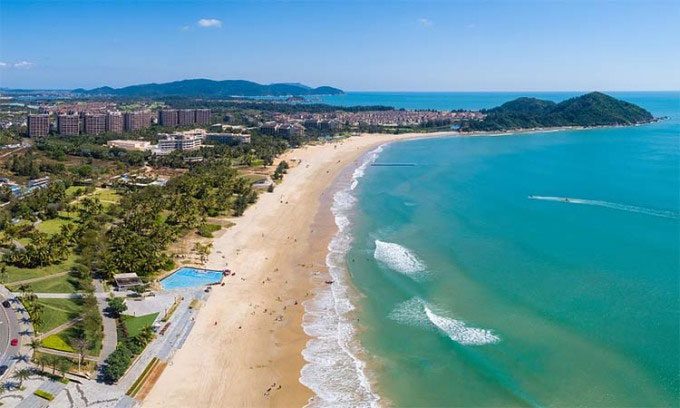Singing Sand – a unique natural phenomenon that produces sound when the wind blows – reflects the distinctive quality of the beaches on Hainan Island.
Scientists have discovered a “singing sand” area along the coastline of Clearwater Bay, Shenzhou Peninsula, and several other regions in Hainan Province, Xinhua reported on June 20. This marks the first time this strange sound phenomenon has been identified along the coast of China.

Singing sand beach at Shenzhou Peninsula, Van Ninh City, Hainan Province. (Photo: CFP)
Singing sand, also known as roaring sand, whistling sand, or musical sand, refers to areas of sand in deserts or beaches that can naturally produce sound in the wind due to a combination of physical characteristics such as the size and composition of the sand grains.
“The discovery of this marvelous natural phenomenon helps fill the gap regarding singing sand along the coast of China. It will support the development and protection of tourism resources in Hainan,” said Qu Jianjun, a researcher at the Northwest Institute of Eco-Environment and Resources (NIEER) under the Chinese Academy of Sciences and the head of the research team.
Singing sand can be found in many places in inland China, including the famous Singing Sand Mountain in Dunhuang, located in the northwest of Gansu Province. “For a long time, it was believed that there were no coastal singing sands in China, and our latest research shows a new answer,” Qu stated.
The recent study indicates that the unique geomorphology and dynamics of these bays contribute to the shaping of coastal sand grains. The team also examined various characteristics of coastal singing sand, such as mineral composition, grain size, surface structure, and acoustic properties, comparing them with desert singing sand.
The surface of the coastal sand features V-shaped indentations formed by mechanical erosion underwater and deep holes created through chemical erosion. “The porous physical structure of the surface is a crucial factor in controlling the sound mechanism of singing sand,” Qu explained.
Additionally, the frequency spectrum of coastal singing sand is narrower than that of desert singing sand, with a significant proportion of high-frequency components and relatively sharp sounds.
The discovery of coastal singing sand reflects the quality of seawater and beaches on Hainan Island. These characteristics are important for tourism resources, generating significant economic, social, and ecological benefits, Qu noted. “We need to conduct further research on conservation issues. In the meantime, establishing a coastal sand park could serve as a foundation for scientific research and education, which would be a great idea,” he suggested.


















































